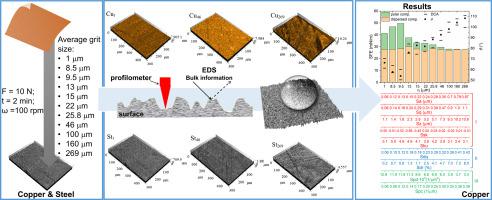Surface & Coatings Technology ( IF 5.3 ) Pub Date : 2021-07-17 , DOI: 10.1016/j.surfcoat.2021.127518 G.V. Kuznetsov 1 , A.G. Islamova 1 , E.G. Orlova 1 , A.S. Ivashutenko 1 , I.I. Shanenkov 1 , I.Y. Zykov 1 , D.V. Feoktistov 1

|
The most urgent problems in meso-, micro- and nano-technological productions are controlling wetting of metals and alloys and liquid spreading over engineering surfaces after their hardware abrasive processing. Nowadays, there is a lack in theoretical basis and comprehensive experimental studies to predict the texture formation and change of the functional surface properties (including wetting) of metals and alloys after abrasive processing. In this study, based on the analysis of the three dimensional roughness parameters (amplitude, hybrid and feature) and elemental composition of the near-surface layer, the features of texture formation, changes in the surface free energy and wettability of copper and steel surfaces that are widely used in industry were established after their hardware abrasive processing. The use of abrasive material with an average grit size of up to 100 μm was found to significantly change the surface roughness. The abrasive processing significantly modifies the polar component in the surface free energy, while not influencing its dispersed component. The texture parameters allowing one to control both the growth and decrease of the polar component in the surface free energy were determined. It is shown that the abrasive processing directly influences the wettability properties and allows varying the contact angles in a sufficiently wide range of from 54.0° to 108.2° (for copper surfaces) and from 71.6° to 89.5° (for steel surfaces).
中文翻译:

粗糙度对铜和钢表面表面自由能极性和分散成分和润湿性能的影响
细观、微米和纳米技术生产中最紧迫的问题是控制金属和合金的润湿,以及在硬件研磨处理后控制工程表面上的液体扩散。目前,缺乏预测金属和合金磨料加工后的织构形成和功能性表面性能(包括润湿性)变化的理论基础和综合实验研究。本研究基于对近表层的三维粗糙度参数(振幅、混合和特征)和元素组成的分析,分析了铜和钢表面的织构形成特征、表面自由能和润湿性的变化。在工业上广泛使用的五金磨料加工后成立。发现使用平均粒度高达 100 μm 的研磨材料可显着改变表面粗糙度。研磨加工显着改变了表面自由能中的极性成分,同时不影响其分散成分。确定了允许控制表面自由能中极性分量的增长和减少的纹理参数。结果表明,研磨加工直接影响润湿性,并允许在 54.0° 到 108.2°(对于铜表面)和从 71.6° 到 89.5°(对于钢表面)的足够宽的范围内改变接触角。同时不影响其分散成分。确定了允许控制表面自由能中极性分量的增长和减少的纹理参数。结果表明,研磨加工直接影响润湿性,并允许在 54.0° 到 108.2°(对于铜表面)和从 71.6° 到 89.5°(对于钢表面)的足够宽的范围内改变接触角。同时不影响其分散成分。确定了允许控制表面自由能中极性分量的增长和减少的纹理参数。结果表明,研磨加工直接影响润湿性,并允许在 54.0° 到 108.2°(对于铜表面)和从 71.6° 到 89.5°(对于钢表面)的足够宽的范围内改变接触角。











































 京公网安备 11010802027423号
京公网安备 11010802027423号